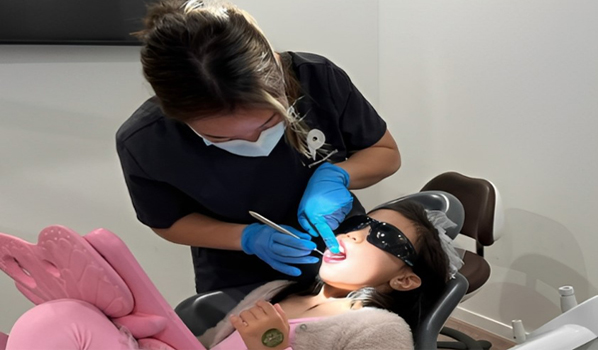What are the Dangers of Gum Disease?
Gum disease (or periodontal disease and periodontitis) is an inflammatory disease caused by dental plaque on the teeth. It occurs when the plaque on your teeth recedes beneath your gum line, causing a bacterial infection that spreads throughout the little pockets in your gums. It can be thought of as an elevated form of gingivitis (inflammation in the gums), and you should always seek the help of a periodontist if you find yourself dealing with the disease.
Periodontitis is often caused when people leave gingivitis untreated for too long, however, it’s important to note that not all gingivitis progresses to gum disease. Periodontitis does, however, have a whole host of potentially negative effects on your overall health, especially in the long run.
Let’s take a closer look at how periodontitis develops, what you should watch for, and – most importantly – how to prevent it from happening.
Periodontitis Signs and Symptoms
As previously mentioned, gum disease is often preceded by gingivitis (although not always). Gingivitis has symptoms such as reddening or swollen gums, bad breath, and bleeding gums when you brush your teeth. It is easily treatable by an adjustment in the patient’s hygiene practices.
But what about periodontitis? Look for these signs:
- Gums that bleed when you brush, and continue to bleed afterwards.
- Red and swollen gums, or gums tender to the touch.
- Consistent halitosis (bad breath) or a bad taste in your mouth that won’t go away.
- Gums receding from your teeth.
Those are the earlier symptoms that are caused by an onset of a bacterial infection, and the first rot setting in at the base of your teeth. Left to its own devices, gum disease will continue to rot your gums, prompting:
- The formation of deep pockets between teeth and gums.
- Loose or shifting teeth.
- A change in how it feels when you bite down (teeth shifting around).
If you have noticed the appearance of these symptoms, you should go and see your dentist as soon as possible.
Treatment of Gum Disease
The main goal of gum disease treatment in nz is to control the infection that has caused the gums to rot. It looks different for each person, and it depends on the severity of each case. For most people who catch it when it’s not in the later stages, periodontitis treatment can be treated using scaling and root planing, or laser surgery if their dental clinic provides that service.
Periodontitis Treatment Options
Scaling: Your dentist scrapes away the plaque from both above and below the gum line, removing the source of the bacteria and thus reducing the possibility that the infection will continue.
Root planing: Your dentist will take a deep dive into your gums and clear out the more stubborn colonies of bacteria that have gathered on any rot.
Laser treatment: This removes plaque and tartar from your teeth and below the gum line using a dental laser. Usually provides more comfort and less healing time for the patient.
Tooth extraction: If there are any teeth where the surrounding gum is too damaged, your dentist will recommend removing the infected tooth and allowing the area to heal so that there is no more risk for bacterial infection from that area.
All three of these methods are aimed at controlling the infection by removing its source, however supplementing the treatment with medication and a regular schedule of dental hygiene is also best practice. For more severe cases you may need surgical intervention, so it’s always best to consult with your dentist.
What happens if you leave periodontitis untreated?
If periodontitis is left alone and untreated, the bacteria and rot will continue to spread throughout the pockets in your gums, causing all of the teeth to loosen and eventually fall out.
Subsequently, it is possible for the rot to move on to the sufferer’s jawbone and begin to degrade it, or the bacteria may jump to the bloodstream and put the person at an elevated risk for:
- Heart disease
- Stroke
- Type II Diabetes
How to avoid developing periodontitis
The key here, as is the key for overall oral health, is to consistently practise good dental hygiene. Follow these tips and you should have very few (if any) problems with your dental health in the future:
- Brush twice a day. Make sure you’re using a soft-bristled brush, as these are far kinder on your gums and won’t cause them to start bleeding or receding from your teeth.
- Floss. This ensures that you get all of the stray pieces of food out of your teeth and gums, because leaving them in there turns your mouth into a bacteria-magnet.
- Scrape your tongue. Most people neglect this step, but this is necessary. Your tongue is a part of your mouth, and leaving it covered in bacteria leaves your teeth and gums vulnerable to infection. Either brush or scrape your tongue as a part of your everyday routine to prevent bacteria build-up.
- See your dentist at least annually. Unfortunately, most people aren’t aware they have gingivitis until they see their dentists, and since it’s a precursor to gum disease, it’s always a good idea to make seeing your dentist a regular occurrence in your calendar.
Get the jump on gum disease.
And finally, if you notice any of the symptoms we’ve outlined above, come in to see us as soon as you can so that we can treat gum disease before it becomes severe. We offer our patients an in-house, interest-free financial plan, so don’t leave something untreated and come in today!







